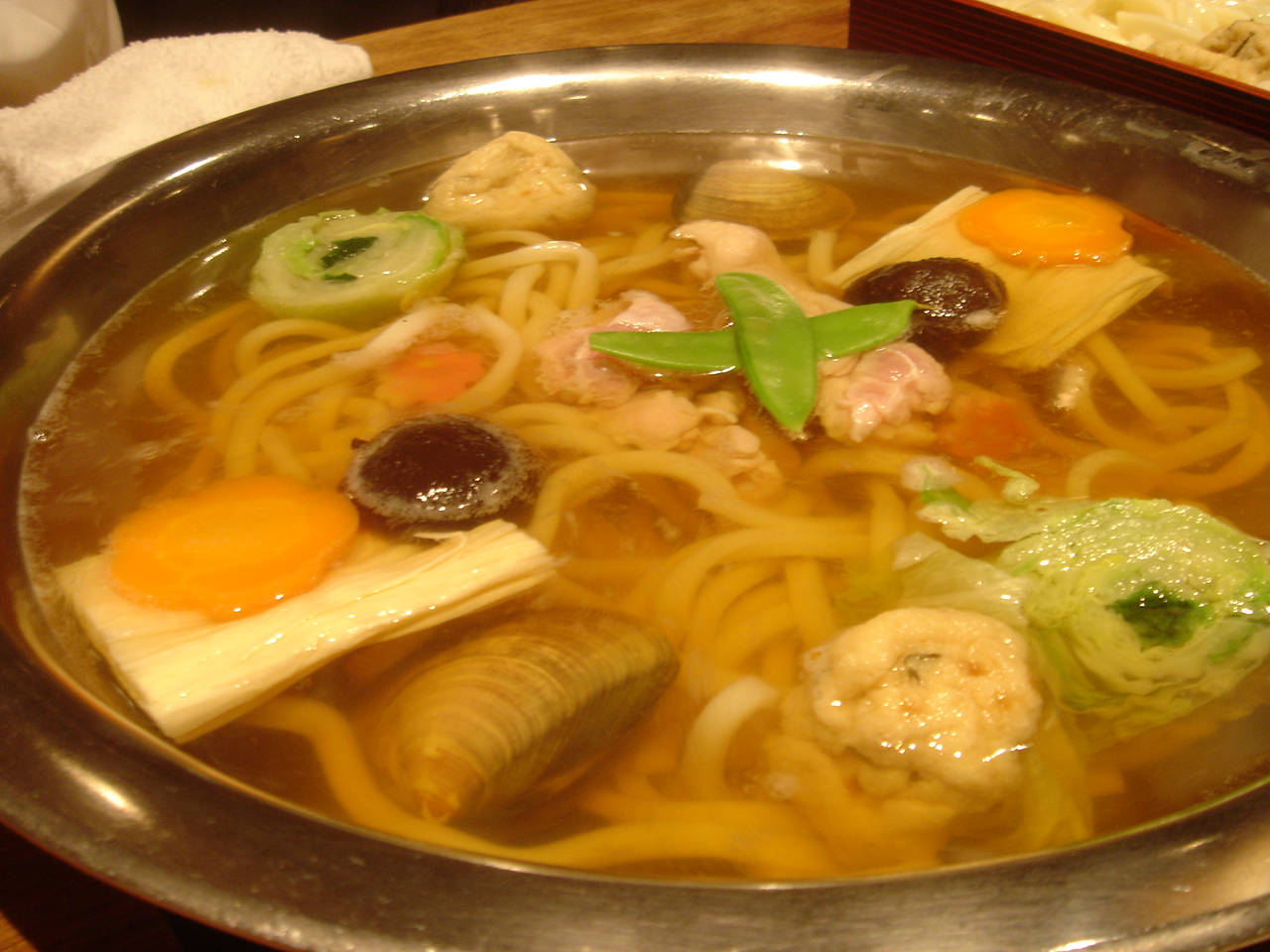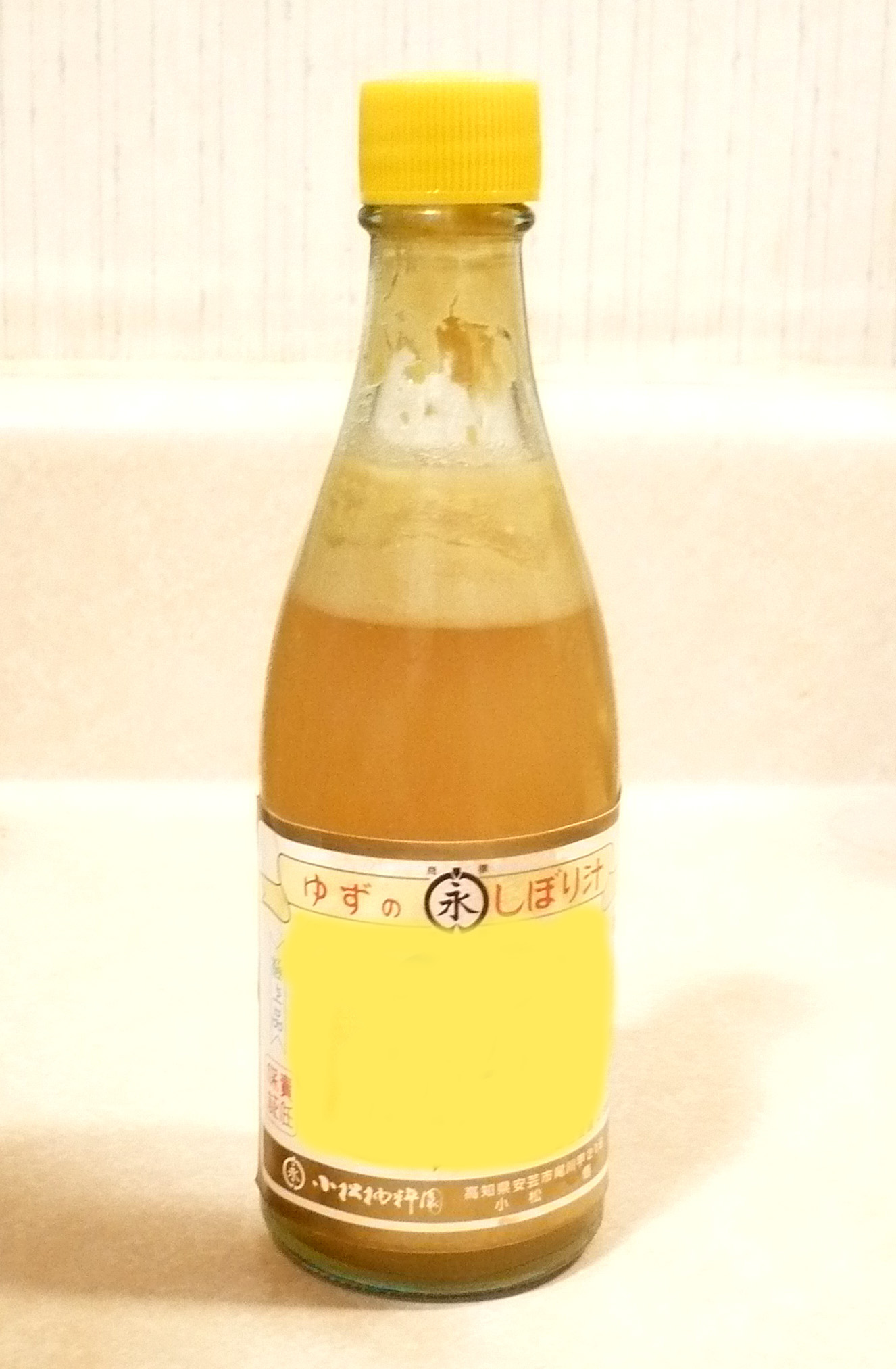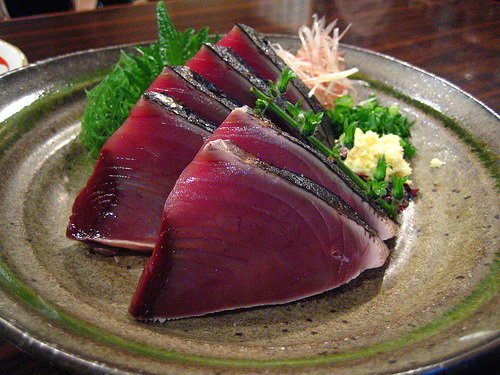|
Ponzu
is a citrus-based sauce commonly used in Japanese cuisine. It is tart, with a thin, watery consistency and nearly colorless. or is ponzu with soy sauce () added, and the mixed dark brown product is widely referred to as simply . The term originally came into the Japanese language as as a borrowing of the now obsolete Dutch word , meaning '' punch'' as in a beverage made from fruit juices. The sour nature of this sauce led to the final being written with the character , meaning " vinegar". Ponzu is made by simmering mirin, rice vinegar, flakes (from tuna), and seaweed () over medium heat. The liquid is then cooled, strained to remove the flakes, and finally the juice of one or more of the following citrus fruits is added: , , , , or lemon. Commercial is generally sold in glass bottles, which may have some sediment. is traditionally used as a dressing for (lightly grilled, then chopped meat or fish) and also as a dip for (one-pot dishes) such as . It is used as ... [...More Info...] [...Related Items...] OR: [Wikipedia] [Google] [Baidu] |
Nabemono
''Nabemono'' (鍋物, なべ物, ''nabe'' "cooking pot" + ''mono'' "thing"), or simply ''nabe'', is a variety of Japanese hot pot dishes, also known as one pot dishes and "things in a pot". Description Nabemono are stews and soups containing many types of ingredients that are served while still boiling. Because of that, Nabe is typically enjoyed in cold days or the winter. In modern Japan, nabemono are kept hot at the dining table by portable stoves. The dish is frequently cooked at the table, and the diners can pick the cooked ingredients they want from the pot. It is either eaten with the broth or with a dip. Further ingredients can also be successively added to the pot. There are two types of nabemono in Japan: lightly flavored stock (mostly with kombu) types such as ''yudōfu'' (湯豆腐) and ''mizutaki'' (水炊き), eaten with a dipping sauce (''tare'') to enjoy the taste of the ingredients themselves; and strongly flavored stock, typically with miso, soy sauce, dash ... [...More Info...] [...Related Items...] OR: [Wikipedia] [Google] [Baidu] |
Shabu-shabu
''Shabu-shabu'' ( ja, しゃぶしゃぶ, shabushabu) is a Japanese '' nabemono'' hotpot dish of thinly sliced meat and vegetables boiled in water and served with dipping sauces. The term is onomatopoeic, derived from the sound – "swish swish" – emitted when the ingredients are stirred in the cooking pot. The food is cooked piece by piece by the diner at the table. Shabu-shabu is generally more savory and less sweet than '' sukiyaki''. History ''Shabu-shabu'' was introduced in Japan in the 20th century with the opening of the restaurant "Suehiro" in Osaka, where the name was invented. Its origins are traced back to the Chinese hot pot known as instant-boiled mutton (''Shuàn Yángròu''). ''Shabu-shabu'' is most similar to the original Chinese version when compared to other Japanese hot-pot dishes ('' nabemono'') such as '' sukiyaki''. The president of the restaurant "Suehiro" in Osaka Chūichi Miyake registered the name as a trademark in 1952. Shabu-shabu became more a ... [...More Info...] [...Related Items...] OR: [Wikipedia] [Google] [Baidu] |
Japanese Words Of Dutch Origin
Japanese words of Dutch origin started to develop when the Dutch East India Company initiated trading in Japan from the factory of Hirado in 1609. In 1640, the Dutch were transferred to Dejima, and from then on until 1854 remained the only Westerners allowed access to Japan, during Japan's '' sakoku'' seclusion period. Numerous exchanges occurred, leading to a branch of Western learning in Japan known as ''rangaku'' (蘭学), or "Dutch learning", where the in ''rangaku'' comes from ''Oranda'', the Japanese word for Holland; ''gaku'' (学) is of Sino-Japanese origin and means "learning". In the process, a number of terms were adopted from Dutch into the Japanese language. At one point, some 3,000 words are thought to have been used, especially in the areas of technical and scientific vocabulary. About 160 such words of Dutch origin remain in use today in standard Japanese. See also * Gairaigo * List of gairaigo and wasei-eigo terms * Japanese words of Portuguese origin Refere ... [...More Info...] [...Related Items...] OR: [Wikipedia] [Google] [Baidu] |
Sashimi
is a Japanese delicacy consisting of fresh raw fish or meat sliced into thin pieces and often eaten with soy sauce. Origin The word ''sashimi'' means "pierced body", i.e. " 刺身" = ''sashimi'', where 刺 し = ''sashi'' (pierced, stuck) and 身 = ''mi'' (body, meat). This word dates from the Muromachi period and was possibly coined when the word " 切る" = ''kiru'' (cut), the culinary step, was considered too inauspicious to be used by anyone other than samurai. This word may derive from the culinary practice of sticking the fish's tail and fin to the slices for the purpose of identifying the fish being eaten. Another possibility for the name is the traditional method of harvesting. "''Sashimi''-grade" fish is caught by individual handline. As soon as the fish is landed, its brain is pierced with a sharp spike, and it is placed in slurried ice. This spiking is called the ikejime process, and the instantaneous death means that the fish's flesh contains a minimal amo ... [...More Info...] [...Related Items...] OR: [Wikipedia] [Google] [Baidu] |
Sudachi
Sudachi (''Citrus sudachi''; Japanese: スダチ or 酢 橘) is a small, round, green citrus fruit of Japanese origin that is a specialty of Tokushima Prefecture in Japan. It is a sour citrus, not eaten as fruit, but used as food flavoring in place of lemon or lime. Genetic analysis shows it to be the product of a cross between a yuzu and another citrus akin to the koji and tachibana orange. General Cultivated for centuries in parts of Japan, and perhaps nearly as well known as the yuzu in that country, it has been considered an "indispensable companion" to eating matsutake mushroom. The , the squeezed citrus juice used as an alternative to vinegar, uses ''sudachi'' among other bitter oranges (''kabosu'' or yuzu juices, and '' daidai'') as an ingredient. The fruit is also the specialty and symbol of the prefecture of Tokushima, which produces 98% of the fruit sudachi in Japan., citing 2011 Ministry of Agriculture figures for Tokushima's 98% share and 2008 data from ''Tokushim ... [...More Info...] [...Related Items...] OR: [Wikipedia] [Google] [Baidu] |
Yuzu
Yuzu (''Citrus junos'', from Japanese or ) is a citrus fruit and plant in the family Rutaceae of East Asian origin. Yuzu has been cultivated mainly in East Asia, though recently also in New Zealand, Australia, Spain, Italy, and France. It is believed to have originated in central China as an F1 hybrid of the ''mangshanyeju'' subspecies of mandarin orange and the ichang papeda. and Supplement Description This fruit resembles a small grapefruit with uneven skin and can be either yellow or green depending on the degree of ripeness. ''Yuzu'' fruits, which are very aromatic, typically range between in diameter but can be as large as a regular grapefruit (up to , or larger). Yuzu forms an upright shrub or small tree, which commonly has many large thorns. Leaves are notable for a large, leaf-like petiole, resembling those of the related makrut lime and ichang papeda, and are heavily scented. Yuzu closely resembles sudachi (''Citrus sudachi'', a Japanese citrus from T ... [...More Info...] [...Related Items...] OR: [Wikipedia] [Google] [Baidu] |
Soy Sauce
Soy sauce (also called simply soy in American English and soya sauce in British English) is a liquid condiment of Chinese origin, traditionally made from a fermented paste of soybeans, roasted grain, brine, and ''Aspergillus oryzae'' or '' Aspergillus sojae'' molds. It is considered to contain a strong umami taste. Soy sauce in its current form was created about 2,200 years ago during the Western Han dynasty of ancient China, and it has spread throughout East and Southeast Asia where it is used in cooking and as a condiment. Use and storage Soy sauce can be added directly to food, and is used as a dip or salt flavor in cooking. It is often eaten with rice, noodles, and sushi or sashimi, or can also be mixed with ground wasabi for dipping. Bottles of soy sauce for salty seasoning of various foods are common on restaurant tables in many countries. Soy sauce can be stored at room temperature. History East Asia China Soy sauce (, ) is considered almost as old as ... [...More Info...] [...Related Items...] OR: [Wikipedia] [Google] [Baidu] |
Toyomansi
Soy sauce (also called simply soy in American English and soya sauce in British English) is a liquid condiment of Chinese origin, traditionally made from a fermented paste of soybeans, roasted grain, brine, and '' Aspergillus oryzae'' or '' Aspergillus sojae'' molds. It is considered to contain a strong umami taste. Soy sauce in its current form was created about 2,200 years ago during the Western Han dynasty of ancient China, and it has spread throughout East and Southeast Asia where it is used in cooking and as a condiment. Use and storage Soy sauce can be added directly to food, and is used as a dip or salt flavor in cooking. It is often eaten with rice, noodles, and sushi or sashimi, or can also be mixed with ground wasabi for dipping. Bottles of soy sauce for salty seasoning of various foods are common on restaurant tables in many countries. Soy sauce can be stored at room temperature. History East Asia China Soy sauce (, ) is considered almost as old as ... [...More Info...] [...Related Items...] OR: [Wikipedia] [Google] [Baidu] |
Kabosu
Kabosu (カボス or 臭橙; binomial name: ''Citrus sphaerocarpa'') is a citrus fruit of an evergreen broad-leaf tree in the family Rutaceae. It is popular in Japan, where its juice is used to improve the taste of many dishes, especially cooked fish, sashimi, and hot pot dishes. Characteristics Kabosu is a juicy citrus fruit closely related to yuzu. Its juice has the sharpness of lemon, and it is used instead of vinegar in some Japanese dishes. It grows on a flowering tree with sharp thorns. The fruit is harvested when still green, but if left to ripen it turns yellow. It is often confused with similar citrus such as sudachi, but can easily be distinguished by the apex of the fruit where the pistil has fallen off, which is a slightly raised torus shape. Origin Thought to be an ichang papeda – bitter orange hybrid, the kabosu was brought over from China in the Edo period and became a popular fruit in Japan. It is produced in most areas of Ōita Prefecture, particularly in ... [...More Info...] [...Related Items...] OR: [Wikipedia] [Google] [Baidu] |
Canada Prime Beef Tataki With Ponzu Pearls And Horseradish (5895881268)
Canada is a country in North America. Its ten provinces and three territories extend from the Atlantic Ocean to the Pacific Ocean and northward into the Arctic Ocean, covering over , making it the world's second-largest country by total area. Its southern and western border with the United States, stretching , is the world's longest binational land border. Canada's capital is Ottawa, and its three largest metropolitan areas are Toronto, Montreal, and Vancouver. Indigenous peoples have continuously inhabited what is now Canada for thousands of years. Beginning in the 16th century, British and French expeditions explored and later settled along the Atlantic coast. As a consequence of various armed conflicts, France ceded nearly all of its colonies in North America in 1763. In 1867, with the union of three British North American colonies through Confederation, Canada was formed as a federal dominion of four provinces. This began an accretion of provinces and terri ... [...More Info...] [...Related Items...] OR: [Wikipedia] [Google] [Baidu] |
Tataki
Two methods of preparing fish or meat in Japanese cuisine are called or . In Japanese, means "pounded" or "hit into pieces". Cooked food In the first method, the meat or fish is seared very briefly over a hot flame or in a pan, and can be briefly marinated in vinegar, sliced thin, and seasoned with ginger (which is ground or pounded into a paste, hence the name). Food so prepared can also be served like sashimi with soy sauce and garnishes. The method originated in Tosa Province, now part of Kōchi Prefecture, where it was applied to bonito (). Lore has it that it was developed by Sakamoto Ryōma, a 19th-century rebel samurai, who picked up the European technique of grilling meat from the foreigners resident in Nagasaki is the capital and the largest city of Nagasaki Prefecture on the island of Kyushu in Japan. It became the sole port used for trade with the Portuguese and Dutch during the 16th through 19th centuries. The Hidden Christian Sites in the .... U ... [...More Info...] [...Related Items...] OR: [Wikipedia] [Google] [Baidu] |
Takoyaki
is a ball-shaped Japanese snack made of a wheat flour-based batter and cooked in a special molded pan. It is typically filled with minced or diced octopus (''tako''), tempura scraps (''tenkasu''), pickled ginger (''beni shoga''), and green onion (''negi''). The balls are brushed with takoyaki sauce (similar to Worcestershire sauce) and mayonnaise, and then sprinkled with green laver (''aonori'') and shavings of dried bonito (''katsuobushi''). ''Yaki'' comes from , which is one of the cooking methods in Japanese cuisine, meaning 'to grill', and can be found in the names of other dishes in Japanese cuisine such as ''okonomiyaki'' and ''ikayaki'' (other famous Osakan dishes). Basically, it is eaten as a snack or between meals, but in some areas it is served as a side dish with rice. History Takoyaki was first popularized in Osaka, where a street vendor named Tomekichi Endo is credited with its invention in 1935. Takoyaki was inspired by akashiyaki, a small round dumpling from ... [...More Info...] [...Related Items...] OR: [Wikipedia] [Google] [Baidu] |

.jpg)

.jpg)





